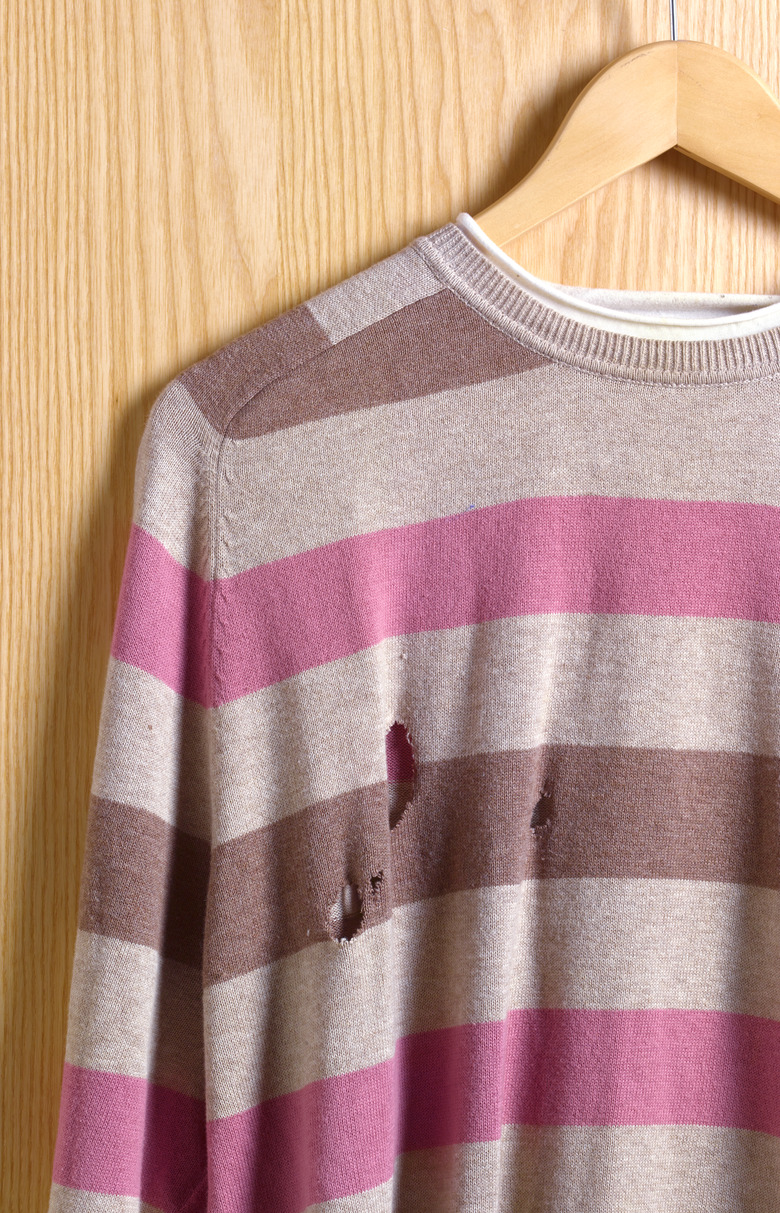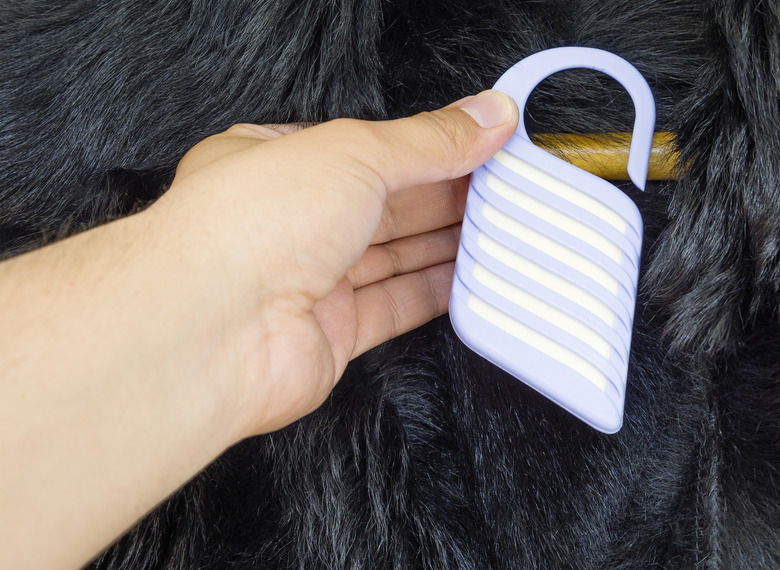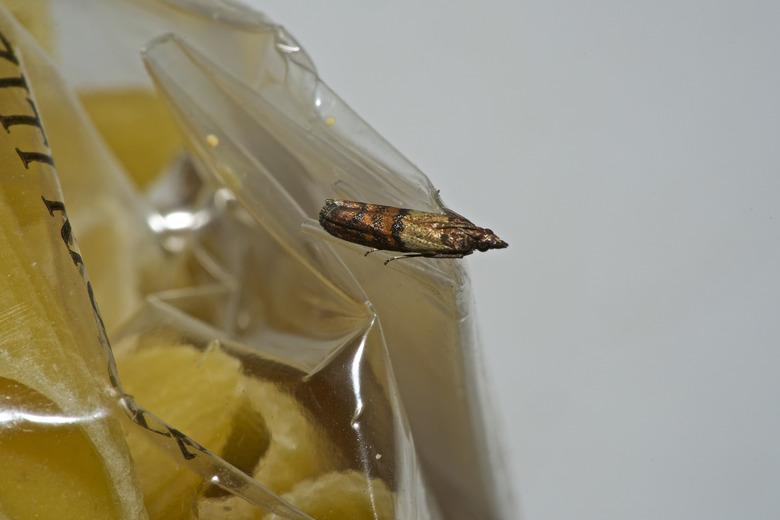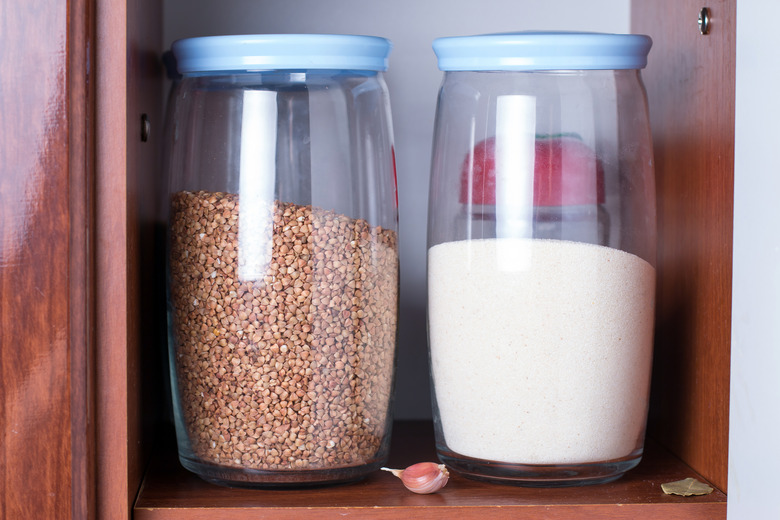How To Get Rid Of Moths
No matter how clean you keep the house, moths happen. Somehow, both closet and pantry moths realize there's a good living environment for their eggs indoors. Before long, you notice telltale holes in clothing or worm-like larvae hiding in an old bag of flour. In either case, getting rid of them can take a bit of effort, as it can be difficult to locate all the eggs and larvae.
Signs of Closet Moth Infestations
Signs of Closet Moth Infestations
If you see small moths flying around indoors or new holes in some articles of clothing, these are signs that moths may be invading your closet spaces. In many cases, you may not even see these moths, as they prefer dark environments and don't fly towards illuminated lamps the other moths do. If you can't figure out where all those holes came from in your favorite sweaters, scarves or hats, think about where you store these items. If they're all stored in the same closet, that closet might well be the source of the problem.
Closet moths, T__ineola bisselliella, lay their eggs in natural fibers. They're particularly fond of items that contain sweat and body oils or food stains—in other words, items that aren't completely clean. As the eggs hatch, they turn into larvae that munch on the fabric fibers. You may not even realize there's an issue until you discover the holes, as both the larvae and moths are only about 1/2 inch long, on average.
Getting Rid of Closet Moths
Getting Rid of Closet Moths
Start by removing all the damaged or potentially larvae-ridden items from the closet. Vacuum the items thoroughly, then wash them in the hottest water possible. If concerned about shrinkage—with wool sweaters, for instance—place them in the freezer in a plastic bag for several days instead. Freezing should kill any moth eggs or larvae.
Next, inspect all remaining clothing and fabric-based items in the closet. Wash them all, if possible, or at the very least vacuum them. Remove everything from the closet, vacuum the carpet or wash the floor, then wipe down the walls and shelves with a damp cloth. Instead of placing all the items back in the closet, store items you need seasonally, such as cotton or wool sweaters, in airtight storage tubs or vacuum bags. Closet moths aren't fans of light, so keep an LED lightbulb on as often as possible in the closet, or leave the door open a bit so light flows in.
While you could spray the entire empty closet with a moth-killing pesticide, such as any containing pyrethrins derived from chrysanthemums, this isn't a good idea. These chemicals, while considered safer than some other pesticides, could cause headaches, nausea and allergic reactions in some people. They're also toxic to fish and amphibians. Instead, opt for traps baited with moth pheromones to catch any lingering suspects.
Hang natural-fiber clothing on cedar hangers, or hang cedar blocks near the clothing to help repel moths. A mixture of rosemary, thyme, clove and bay leaves placed in a mesh bag can also repel moths. Make sure clothing is completely clean before hanging it in the closet, too, as this cuts down on the fabric's appeal to moths.
Signs of Pantry Moth Infestations
Signs of Pantry Moth Infestations
Another moth pest that can be a problem is the pantry moth (Plodia interpunctella), also known as the India meal moth. As with closet moths, it is the larvae of the pantry moth that you might notice before the flying moths themselves. These larvae appear as little white worms and webbing inside containers of cereal, bird seed, flour, dry pet food and even candy. If dried goods exhibit starting wriggling inside the container or once you've poured them out, you're most likely seeing the work of pantry moths. Sometimes, you'll see the tiny insect casings among the grains or dried goods. These moths also leave behind evidence outside the pantry, in the form of tiny, web-like cocoons in dark corners or atop cabinets. The actual moths may be seen, as well, flying around towards lights at night. These brown moths are much smaller than most outdoor moth varieties, measuring about 1/2 inch long.
Getting Rid of Pantry Moths
Getting Rid of Pantry Moths
Getting rid of pantry moths can be a bit tedious, as their eggs or larvae may be hiding in several areas. Immediately place any affected products in a trash bag, tie it shut, and place it in a trash can outdoors. Get rid of any items that may be suspect as well, such as bags of dry mixes that haven't been used in a long time. In some cases, those eggs or larvae may have infiltrated the products long ago while still in a warehouse or store.
Since the larvae can travel far beyond where they hatched from eggs, you'll have to clean out the entire pantry or cupboard. Remove all the items, discard boxes and bags that could be home to moth eggs and larva, and wipe down any jars, cans and airtight containers.
- Check the inside of the empty cupboard or pantry with a flashlight, as there may be cocoons or larva in the corners or under shelves.
- Wipe everything down with a mixture made from equal parts water and white vinegar. Add several drops of peppermint essential oil to the liquid to help repel moths.
- Clean the pantry regularly, as any food residue could attract more moths to the space.
- Place any freezable food items you wish to keep, such as new packages of dried beans, in the freezer for several days to kill off potential moth eggs.
- Storing grains and dried goods in airtight glass jars also helps prevent future infestations. The freezer is also a good place to store any such items you don't use frequently, such as pastry flour.
References
- Country Living: How to Get Rid of Moths
- Earthkind: How to Get Rid of Moths from Your Home Safely and Permanently
- Today's Homeowner: How to Get Rid of Pantry Moths and Larvae in Your Kitchen
- The Old Farmer's Almanac: How to Get Rid of Pantry Moths and Worms
- Agency for Toxic Substances and Disease Registry: Public Health Statement for Pyrethrins and Pyrethroids



